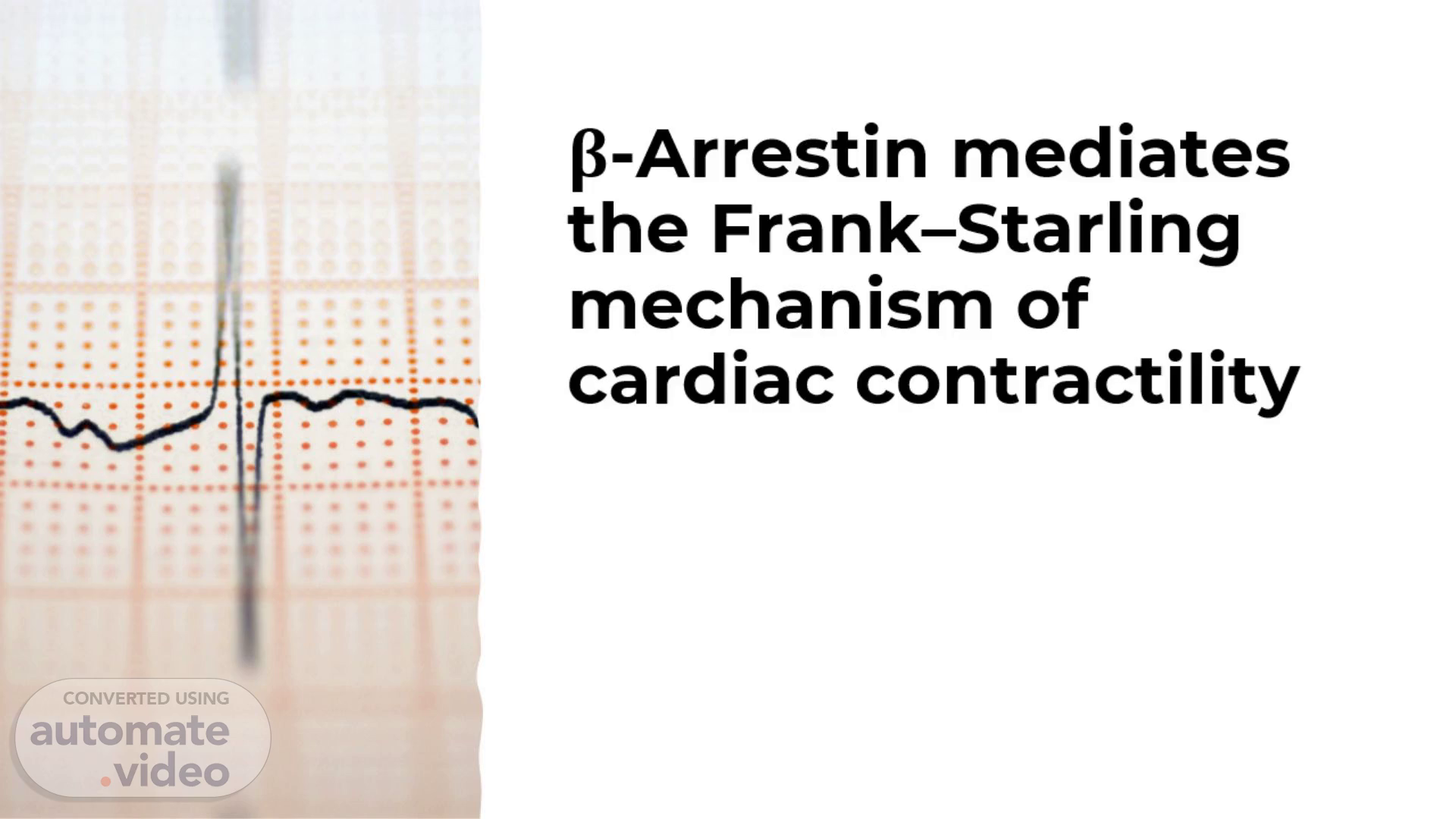
Page 1 (0s)
[Audio] Cardiac contractility is an essential mechanism for the proper functioning of the heart. β-arrestin is known to play an important role in the Frank–Starling mechanism, which is the primary mechanism for controlling contractility. Recently, scientists studied the interaction between β-arrestin and voltage-gated L-type calcium channels, which regulate calcium flow into cardiac myocytes. To observe and analyze the complex interactions between β-arrestin and the voltage-gated L-type calcium channels, they used electromagnetic radiation. These insights will help researchers and clinicians understand the physiology of this important mechanism better..
Page 2 (44s)
[Audio] The Frank-Starling law of the heart is a vital element in cardiac contractility, stating that the stroke volume of the heart increases in response to a rise in the end-diastolic volume, that being the amount of blood that fills the ventricles prior to contraction. This means it is not necessary for external regulation to make any alterations, as this process assists in keeping a balance between the left and right ventricular output. Consequently, it proves to be a remarkable instrument in ensuring cardiac contractility remains running efficiently in the body..
Page 3 (1m 20s)
[Audio] The Frank-Starling law of the heart is an intrinsic property of heart muscle that states the increase in cardiac filling leads to an increased cardiac contractility. Over time, understanding of the law has progressed and it has been established that it involves a length-dependent enhancement of the cardiac myofilament calcium sensitivity. β-Arrestin holds major importance in this mechanism of cardiac contractility in its ability to influence the length-dependent enhancement..
Page 4 (1m 51s)
[Audio] β-arrestin and the Angiotensin II Type 1 Receptor (AT1R) are essential in comprehending the Frank-Starling mechanism of cardiac contractility. β-arrestin is a protein that boosts the survivability of cardiac tissue and augments the ability of the heart to contract through the AT1R. Recently identified β-arrestin-biased AT1R ligands have been identified to potentially bolster heart performance. These ligands highlight the significance of β-arrestin and AT1R's association in sustaining normal cardiac functioning..
Page 5 (2m 27s)
[Audio] Our research has centred on the Frank-Starling mechanism, a key process that assists in the regulation of cardiac contractility. We are looking into the part β-arrestin and AT1R play in this mechanism in order to extend our knowledge of the molecular workings of the procedure. We believe that β-arrestin and AT1R are necessary elements, mediating cardiac contractility through a particular signalling pathway that reacts to mechanical stretch. Investigating these components should give us valuable understanding into the Frank-Starling mechanism and its consequences on heart functioning..
Page 6 (3m 7s)
[Audio] This research examined the role of β-arrestin and AT1R in the Frank–Starling mechanism. To do this, mice of four different types were used: wild-type, β-arrestin 1 and 2 knockouts, and AT1R knockouts. Furthermore, pharmacological agents were employed to modulate β-arrestin–biased AT1R signalling. Invasive hemodynamics, ex vivo cardiac stretching and skinned muscle fibre preparations were performed to test the role of β-arrestin and AT1R in the Frank–Starling mechanism. The results of these experiments showed the importance of β-arrestin and AT1R in the Frank–Starling mechanism and shed light on how the cardiovascular system is regulated..
Page 7 (3m 57s)
[Audio] β-arrestin has been investigated for its effects on the Frank-Starling mechanism of cardiac contractility. We compared the effects it has on cardiac loading across various mouse genotypes by measuring the end-diastolic pressure/volume relationship. LVEDP and LVEDV were utilized as indices of cardiac loading, with stroke volume and cardiac filling pressures being assessed at different levels of LVEDP. Our findings showed that stroke volume increased when LVEDP increased in wild-type mice..
Page 8 (4m 29s)
[Audio] The difference in stroke volume measured was not attributed to hemodilution. β-Arrestin is a key protein for the Frank–Starling mechanism of cardiac contractility, and it is a significant factor in determining the highest rate of increment of left ventricular pressure. Our research outcomes demonstrate that hemodilution was not the cause of the variation in stroke volume observed..
Page 9 (4m 57s)
[Audio] Studies have shown that cardiac beta-arrestin 1 and 2 play an important role in allowing the full utilization of the Frank-Starling mechanism of force generation. In a Langendorff perfused model, WT left ventricles exhibited a 20% increase in dP/dtmax after only one cycle of cardiac strain. However, in beta-arrestin 1 and 2 knockout mice, this increase was significantly reduced, and furthermore, force development was found to be markedly attenuated for up to 30 cardiac cycles..
Page 10 (5m 35s)
[Audio] Research has revealed that when the sarcomere length is increased from 1.9 μm to 2.3 μm, there is a significant leftward shift in the force-pCa2+ curve, indicating the significant reliance of myofilament length on force production in heart muscle. However, ventricular muscle fibres from β-arrestin 1 and β-arrestin 2 KO hearts did not demonstrate the same shift, indicating that length-dependent force activation is significantly decreased. This implies that both β-arrestin 1 and β-arrestin 2 are essential for length-dependent force activation in the Frank–Starling mechanism of cardiac contractility..
Page 11 (6m 21s)
[Audio] This study has confirmed the critical role of β-arrestin 1, β-arrestin 2, and AT1R in the Frank-Starling mechanism of cardiac contractility. β-arrestin and AT1R are responsible for force activation that depends on the length. This study suggests β-arrestin–biased AT1R signaling as a potential way of improving heart contractility. It has also highlighted some limitations and achievements, such as the influence of other factors (e.g., titin, phosphorylation, and hemodilution) and the lack of information on how β-arrestin and AT1R influence myofilament Ca2+ sensitivity..
Page 12 (7m 6s)
[Audio] Concluding, the research of Abraham et al. has demonstrated the role of β-arrestin and AT1R in the Frank-Starling mechanism of cardiac contractility. This newfound information has created the possibility of crafting β-arrestin–biased AT1R ligands for the treatment of heart failure. We appreciate your consideration..